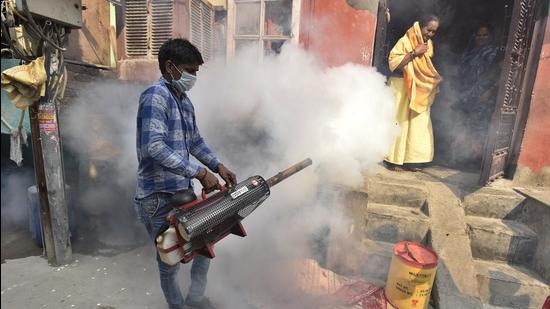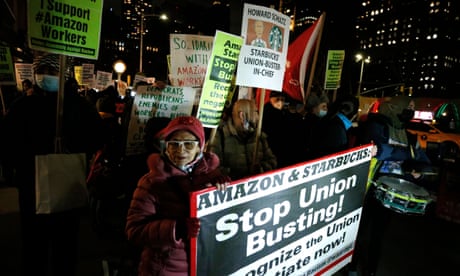The ski patrol union in Park City has raised over $56,000 for a solidarity fund since Christmas.
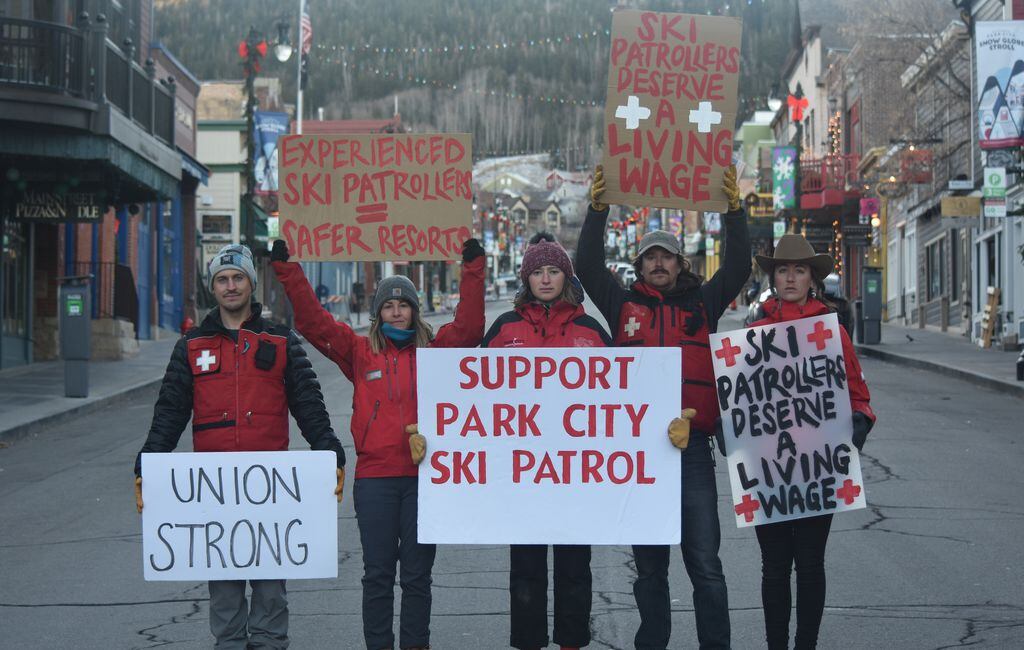
(Willie Maahs) The Park City Professional Ski Patrol Association has been pushing for a new contract with Vail Resorts since August 2020. In this courtesy photo, union members Tyler Grundstrom, Kate Foley, Lee Moriarty, Emmet Murray and Katie Woodward hold signs in Park City.
By Zak Podmore
| Jan. 6, 2022
Park City • The vacation giant Vail Resorts announced a $15 starting hourly wage for 14 of its ski areas last summer, boosting pay for thousands of its workers across the United States.
Restaurant staff, lift operators, parking attendants and ticket sellers all benefited from the policy. But one group has so far been left out: unionized ski patrollers at the Vail-owned Park City Mountain in Utah.
Ski patrollers — who train as first responders to provide on-mountain medical care and mitigate avalanche danger with explosives and other means — are still starting at $13.25 per hour, making rookie patrollers the lowest paid employees at Park City resort. Second year patrollers start at $14.50 per hour.
The corporation has offered the Park City Professional Ski Patrol Association, a union that represents just under 90% of the roughly 180 Park City patrollers, a $15 an hour starting wage during contract negotiations that have been dragging on for nearly a year and a half.
But the union has so far rejected those offers, according to Patrick Murphy, the union’s business manager, arguing they have fallen below industry standards.
“I think we’ve made it abundantly clear that that base wage offer comes short of being an appropriate and fair wage for what our job is — what we do on the ground,” Murphy, who has worked on the Park City’s ski patrol for five years, said.
The union is asking for a starting hourly wage of $17 with a one dollar per hour increase over the first three years of employment, which Murphy argued would better reflect the training, site-specific knowledge and exposure to inherent risks that are required to run a successful ski patrol program and keep guests safe.
“Name any resort in the West that runs an avalanche mitigation program comparable to ours,” he said. “They’re making at least $17 an hour for rookies.”
On Monday night, the union and Park City management held their 47th bargaining session since August 2020, and they again failed to reach an agreement after Vail offered $15 per hour again with only slight concessions on incentive pay.
“We’re surprised and disappointed that they continue to come back to that same base wage offer,” Murphy said.
Vail Resorts declined an interview request, but said in a written statement that it has “tremendous respect” for patrollers at its resorts, including at Park City, and has “listened to the concerns.”
“In this challenging staffing environment, we are proud that patrol is one our best staffed functions across our resorts,” the statement said. “Additionally, we were pleased that unionized patrols at two of our resorts recently agreed, overwhelmingly, to very similar terms as what we are offering Park City Ski Patrol. We remain actively engaged in conversations with the Park City Ski Patrol union and, given the progress already made, we certainly believe all parties should avoid any disruptions to this season.”
Solidarity fund offers options
The union launched a solidarity fund drive on Christmas Day that could compensate union members in the event of a work stoppage or strike, which the union has called a “worst case scenario.” As of Wednesday, nearly 1,000 people had contributed a total of $56,000 to the fund.
“It’s been incredible for us to see the community show up and support us so strongly,” said union president Brian Spieker. “We’re hoping that [the fund] is just one more tool in the arsenal that … gives us some options should we need to exercise it.”
The existence of the fund has not yet led to any major breakthroughs in the bargaining process, though Spieker said communications between the resort and the union have improved.
Murphy said the union is still discussing its next steps after failing to reach an agreement Monday.
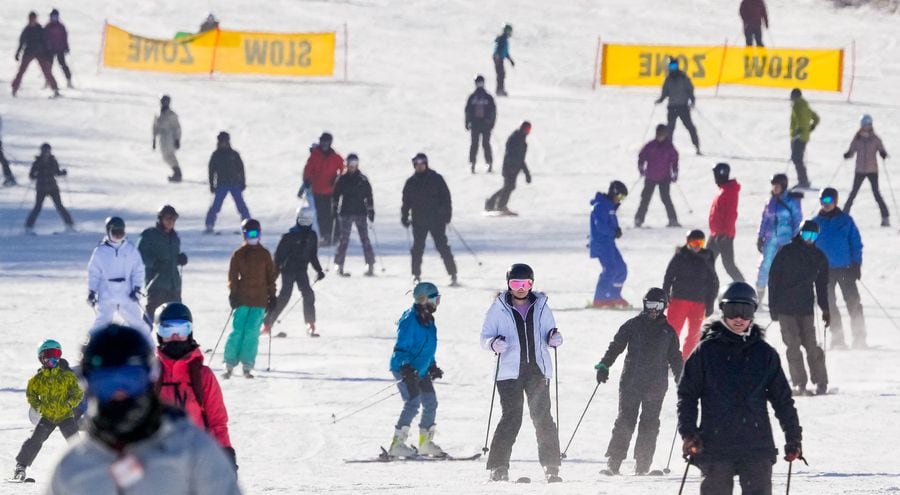
(Francisco Kjolseth | The Salt Lake Tribune) People take to the slopes of Park City Mountain Resort as clear skies and some recent fresh snow draws the crowds on Saturday, Dec. 18, 2021.
A strike by the Park City ski patrol would likely shut down Utah’s biggest ski resort, which along with other Vail-owned resorts is already struggling with understaffing, record numbers of visitors and long lift lines. Office staff have been helping run lifts at Park City this year, according to several ski patrollers who spoke to The Salt Lake Tribune, but it would be much more difficult to replace highly trained ski patrollers in the event of a work stoppage.
There are over 150 unique avalanche slide paths on the Canyons Resort side of Park City alone, said patroller Marla Gutmann. After four years on the ski patrol, Gutmann has been certified as a route leader on two of those paths.
“It’s not something that you can just learn as a rookie,” Gutmann said. “It takes a lot of time and training.”
Murphy said the current pay structure and incentives offered to patrollers at Park City has led to high turnover and the loss of institutional knowledge.
“You need to know the nuances of the terrain for medical transport and extrication,” he said. “So these are the things that I’m concerned we’re beginning to lose as retention drops — we’re losing experience and losing those good patrollers.”
Vail Resorts reported having nearly $1.5 billion in cash on hand at the time of its latest financial filings, and it purchased several new ski areas last year after pre-selling a record 2.1 million day tickets and passes for the current ski season.
“Sales have increased this year,” said Kate Foley, a fourth-year ski patroller and vice president of the union on the Canyons side of Park City. “It’s taken more money to fight us this whole time than it would have to meet us where we think it’s a fair starting place.”
Foley added that negotiations have never taken this long before.
A $2 an hour raise for fewer than 200 employees may not sound like a lot given Vail’s billions of dollars in annual revenue, but Marshall Steinbaum, assistant professor of economics at the University of Utah, said there may be other considerations at play.
“It’s probably easy enough for the company to meet the financial demands of this relatively small set of workers, but the precedent is costly for them,” Steinbaum said.
“In this case,” he added, “it seems like you have a small ‘craft’ union in a large company that employs many workers with either fewer skills or fewer labor rights, being immigrants with conditional work authorizations (or both), and the company does not want any gains by that union representing a small share of its workforce to influence the demands other workers would make.”
Vail has a long history of discouraging unionization efforts among its workers and has hired anti-labor consultants to fight union drives at Colorado resorts. Last year, the corporation offered bonuses to many of its employees but initially cut out union members, arguing it couldn’t provide bonuses under the terms of the union contract. (Vail eventually reversed course.)
“Once a union is formed,” Steinbaum said, “research shows that workplaces become permanently better-paid, and shareholders and executives lose out.”
Former Vail Resorts CEO Robert Katz, who stepped down in November, made $2.8 million in compensation in 2020.
In the early 20th century, Park City was the site of high-profile strikes by mine workers organized with the Western Federation of Miners and the Industrial Workers of the World. Labor organizer and songwriter Joe Hill worked at a silver mine in Park City before he was convicted of murder in a controversial trial and executed by a firing squad in Salt Lake City in 1915, sparking nationwide protests.
But Utah has all but lost its tradition of labor militancy in recent decades and union membership has steadily declined in the U.S. since the 1950s. As the Deseret News recently noted, Park City was the site of the only strike in all of Utah last year when eight non-union cinema employees walked out for two weeks, eventually gaining a $2 per hour raise.
Whether or not the resort town will see more labor actions in 2022 remains to be seen, but Spieker, the union president, said the rapid growth of the solidarity fund has been heartening.
“We’re phenomenally grateful for the overwhelming outpouring of support that we have experienced,” he said. “I think it has made [ski patrollers] feel like what they do does make a difference and is appreciated by the community.”
Zak Podmore is a Report for America corps member for The Salt Lake Tribune.
Park City ski patrol union raises over $50,000
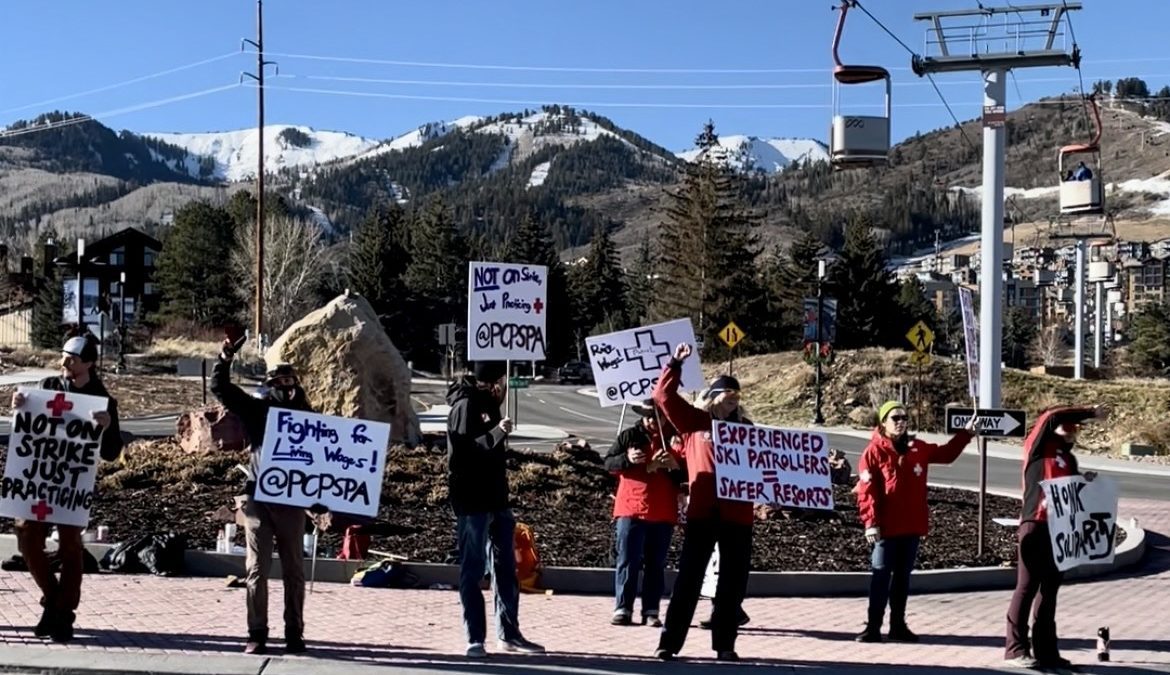
The Park City Professional Ski Patrol Association's "solidarity fund" has raised over $50,000. Photo: TownLift
PARK CITY, Utah — The Park City Professional Ski Patrol Association (PCPSPA) has raised over $50,000 through its “solidarity fund” on GoFundMe, as contract negotiations continue between the union and Park City Mountain owner Vail Resorts.
PCPSPA labeled the fund a “safety net in the event we are forced into more significant action, and we are not receiving paychecks,” and added, “it is only utilized to help patrollers pay for basic needs such as rent and food in our last/worst-case scenario.” As of Monday evening, the union received 918 individual donations.
There is a bargaining session between the two parties scheduled for Monday night. PCPSPA recently rejected a proposed contract with starting wages at $15 an hour. Union patrollers are currently paid $13.25 an hour. Given the lack of a current agreement, union members follow the policies of the last expired contract, which ended on May 1, 2021.
The union’s goal is a $17 an hour starting wage. PCPSPA Business Manager Patrick Murphy has said it isn’t fair for the union to have the resort-wide starting wage of $15 an hour, given the physical challenges of ski patrol. He also said the union wants to see more wage incentives for experienced patrollers.
Park City Mountain Chief Operating Officer Mike Goar, a former patroller at Solitude in Big Cottonwood Canyon, told TownLift he has “an appreciation and understanding of what it takes to be a patroller” and “a great deal of appreciation for the hard work and the skill set it takes.”
He called the rejected proposal “excellent” and referenced recently ratified contracts with other patrol unions at Vail Resorts.
